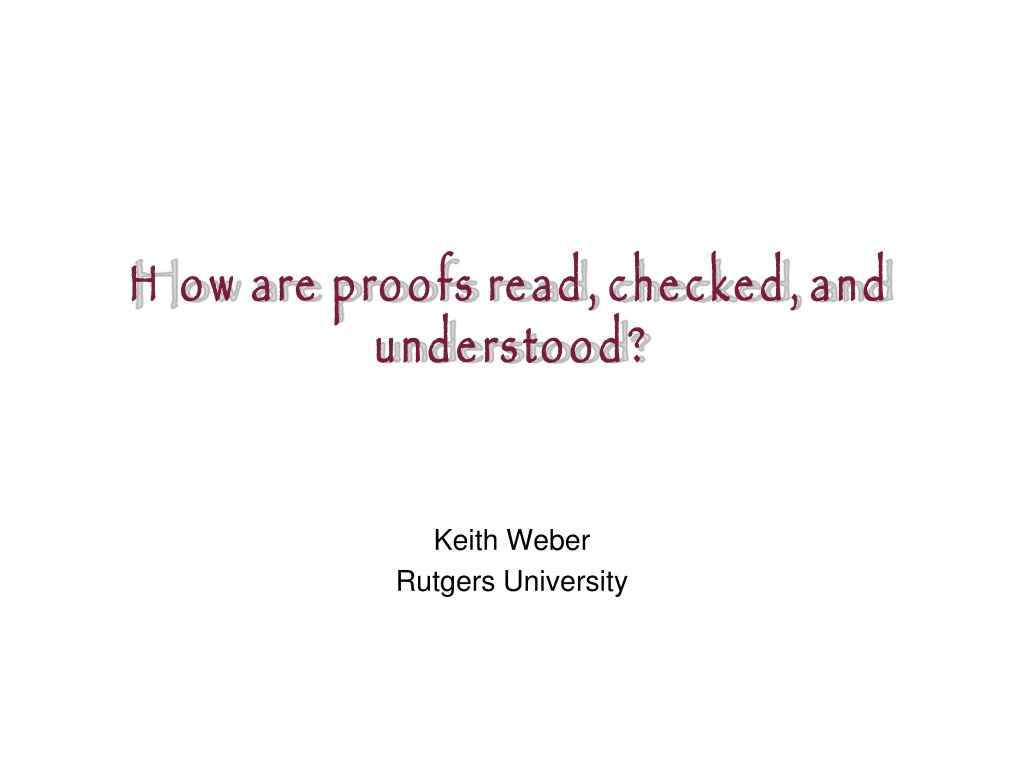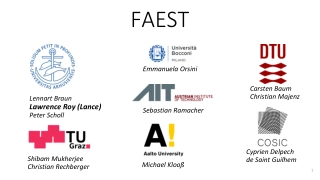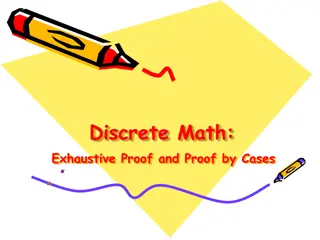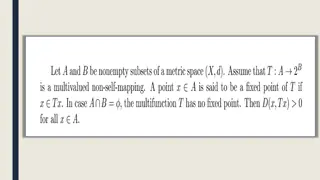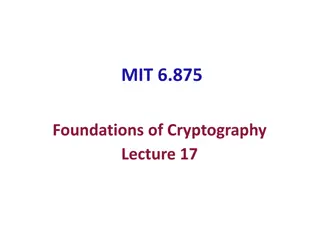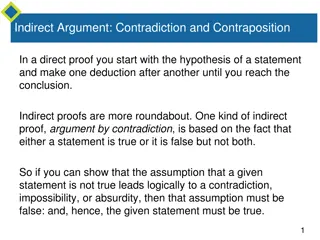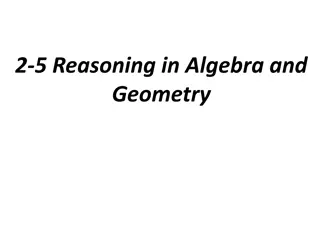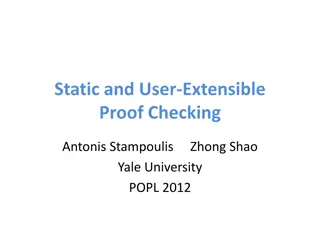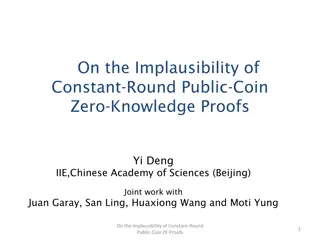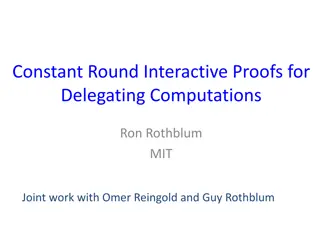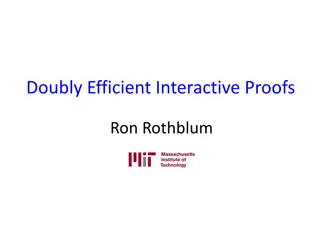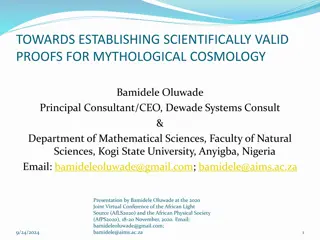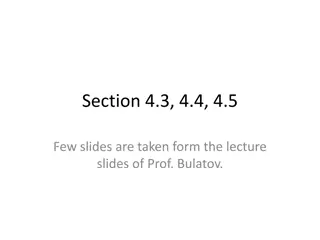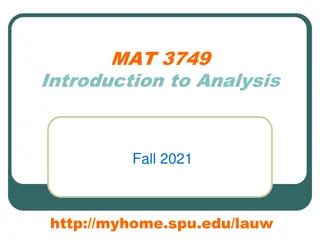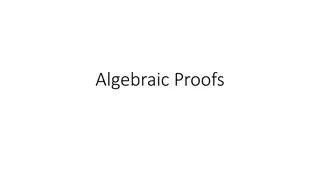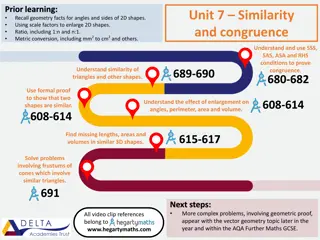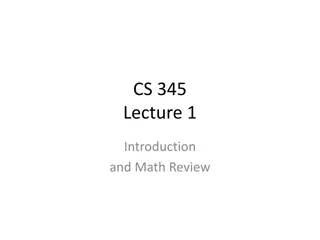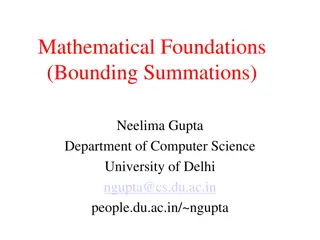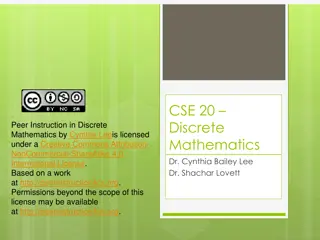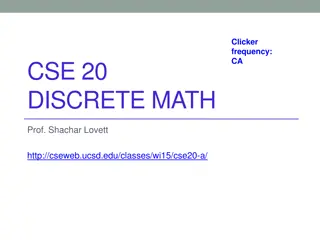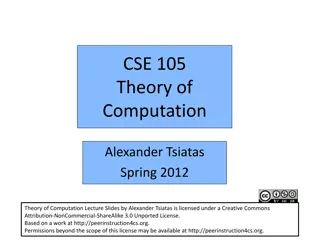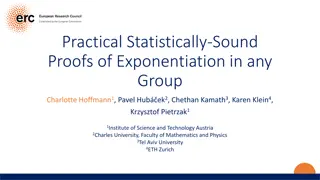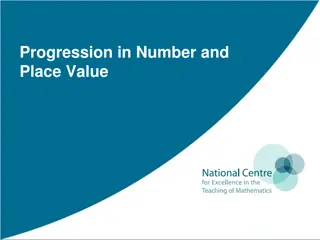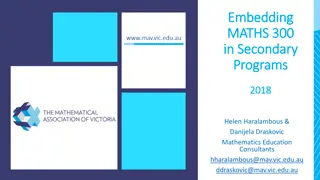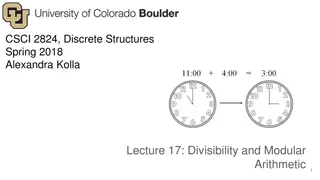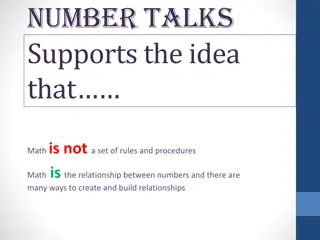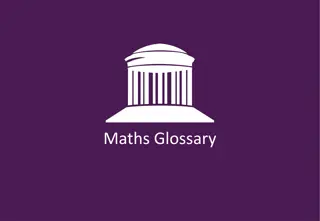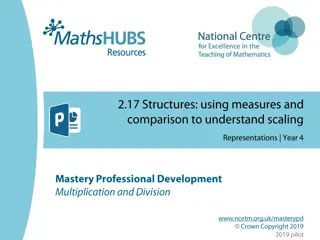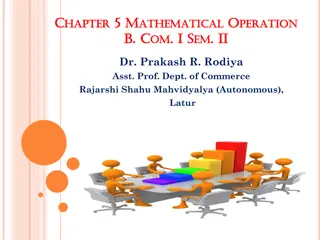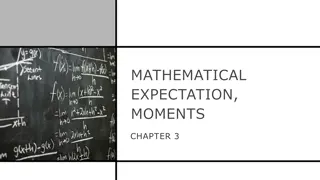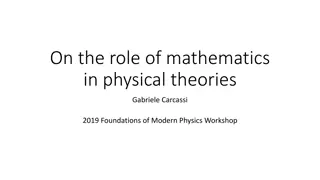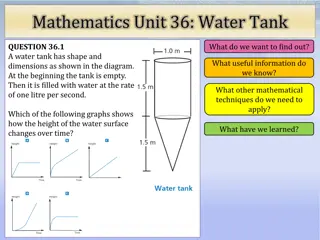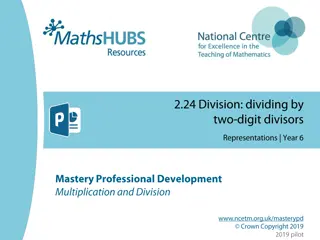Understanding and Checking Mathematical Proofs
Reading and understanding mathematical proofs involves careful analysis of logic and reasoning. Mathematicians and students use various strategies to ensure correctness, such as examining assumptions, following step-by-step logic, and verifying conclusions. This process is crucial for grasping the validity and structure of mathematical arguments. Additionally, research by Keith Weber from Rutgers University illuminates how mathematicians assess proof validity and the perceptions of mathematics majors towards proof conviction. By delving into the intricacies of proof interpretation and assessment, individuals can enhance their comprehension and proficiency in mathematical reasoning.
Download Presentation

Please find below an Image/Link to download the presentation.
The content on the website is provided AS IS for your information and personal use only. It may not be sold, licensed, or shared on other websites without obtaining consent from the author. Download presentation by click this link. If you encounter any issues during the download, it is possible that the publisher has removed the file from their server.
E N D
Presentation Transcript
H ow are proofs read, checked, and understood? H ow are proofs read, checked, and understood? Keith Weber Rutgers University
P lan for today P lan for today How do students and mathematicians check proofs for correctness? How and why do mathematicians read proofs? How can we measure students proof understanding? How can we help students understand proofs better?
P lan for today P lan for today Students understanding of a proof depends less on how proofs are presented and more on the activity that they engage in.
For any positive integer n, if n2is divisible by 3, then n is divisible by 3. Proof. Assume that n2is a positive integer that is divisible by 3. That is, n2= (3n+1)2= 9n2+ 6n + 1 = 3n(n+2) + 1. Therefore, n2is divisible by 3. Assume n2is even and is a multiple of 3. Then n2= (3n)2= 9n2= (3n)(3n). Therefore, n2is a multiple of 3. If we factor n2=9n2, we get (3n)(3n) which means that n is divisible by 3.
For any positive integer n, if n2is divisible by 3, then n is divisible by 3. Proof. Assume that n2is a positive integer that is divisible by 3. That is, n2= (3n+1)2= 9n2+ 6n + 1 = 3n(n+2) + 1. Therefore, n2is divisible by 3. Assume n2is even and is a multiple of 3. Then n2= (3n)2= 9n2= (3n)(3n). Therefore, n2is a multiple of 3. If we factor n2=9n2, we get (3n)(3n) which means that n is divisible by 3. Would undergraduate math students recognize this as incorrect? If a student did recognize this as valid, what might they be thinking?
Claim. For any positive integer n, if n2is divisible by 3, then n is divisible by 3. Proof. Let n be an integer such that n2is divisible by 3. Let k be an integer such that such that n2= 3k. Since n2= 3k, n x n = 3k. Thus, 3|n. Therefore if n2is a multiple of 3, then n is a multiple of 3.
R eading proofs and checking proofs for correctness R eading proofs and checking proofs for correctness Weber, K. (2008). How mathematicians determine if an argument is a valid proof. Journal for Research in Mathematics Education, 39, 431-459. Weber, K. (2010). Mathematics majors perceptions of conviction, validity, and proof. Mathematical Thinking and Learning, 12, 306- 336.
R eading proofs and checking proofs for correctness R eading proofs and checking proofs for correctness We present students with proofs, in part, so they can have a good reason to believe that theorems are true. But if they are to obtain legitimate conviction, they need to distinguish good proofs from bad (Selden & Selden, 2003). There have been a large number of studies in which undergraduate mathematics students have asked students to check proofs for correctness. In each study, the students have performed very poorly, and cannot distinguish correct proofs from invalid arguments (Inglis & Alcock, 2012; Ko & Knuth, 2013; Selden & Selden, 2003; Weber, 2010).
R eading proofs and checking proofs for correctness R eading proofs and checking proofs for correctness For any positive integer n, if n2is divisible by 3, then n is divisible by 3. Proof. Assume that n2is a positive integer that is divisible by 3. That is, n2= (3n+1)2= 9n2+ 6n + 1 = 3n(n+2) + 1. Therefore, n2is divisible by 3. Assume n2is even and is a multiple of 3. Then n2= (3n)2= 9n2= (3n)(3n). Therefore, n2is a multiple of 3. If we factor n2=9n2, we get (3n)(3n) which means that n is divisible by 3. Across two studies, 13 out of 26 students found this to be invalid.
R eading proofs and checking proofs for correctness R eading proofs and checking proofs for correctness The literature often says that undergraduates are at chance level when checking proofs for correctness. But that s not quite right. Students will usually confirm correct proofs are valid. But they will also frequently evaluate incorrect proofs as valid. On a positive note, if interviewers talk with students about the proof and ask them to explain aspects of the proof, students performance can improve dramatically (Selden & Selden, 2003).
W hat do mathematicians do when they check proofs for correctness? W hat do mathematicians do when they check proofs for correctness? I conducted task-based interviews with 8 mathematicians. They were handed purported proofs, one-by-one, and asked to think aloud while determining if the proofs were valid. Four were student-generated proofs from the Selden and Selden (2003) study on student proof reading, Four were more advanced proofs in number theory taken from expository journals such as American Mathematical Monthly. (One was a foil with a mistake that I generated). Mathematicians scored eight proofs or stopped when 45 minutes elapsed (whichever came first) and then asked general questions about how they read proofs.
A n interesting case A n interesting case Claim. For any positive integer n, if n2is divisible by 3, then n is divisible by 3. Proof. Let n be an integer such that n2= 3x, where x is an integer. Then 3|n2. Since n2= 3x, n x n = 3x. Thus, 3|n. Therefore if n2is a multiple of 3, then n is a multiple of 3.
A n interesting case A n interesting case Claim. For any positive integer n, if n2is divisible by 3, then n is divisible by 3. Proof. Let n be an integer such that n2= 3x, where x is an integer. Then 3|n2. Since n2= 3x, n x n = 3x. Thus, 3|n. Therefore if n2is a multiple of 3, then n is a multiple of 3. 5 mathematicians said invalid, 2 mathematicians said valid, 1 said he couldn t decide. Inglis and Alcock (2012) found 7 mathematicians said invalid, 5 valid.
W hat did mathematicians do? W hat did mathematicians do? Mathematicians would first check to see if the structure of the proof was valid (i.e., the assumptions and conclusion of the proof were sensible), and then proceed to check if each step followed from previous assertions. I will first try to understand the structure of the proof, to get a feel for the argument that s being used. After that, if that s reasonable, I ll check the individual steps to make sure each of them are valid .
W hat did mathematicians do? L ine W hat did mathematicians do? L ine- -by by- -line check line check There were 77 instances in which a participant encountered a step in the proof that they were initially unsure of.
W hat did mathematicians do? L ine W hat did mathematicians do? L ine- -by by- -line check line check There were 77 instances in which a participant encountered a step in the proof that they were initially unsure of. In 15 cases, they constructed a sub-proof. In 33 cases, they constructed an informal argument. In 19 cases, they resolved their doubt by checking the claim with examples. 10 other cases were idiosyncratic and could not be classified (i.e., coded as other ).
W hat did mathematicians do? L ine W hat did mathematicians do? L ine- -by by- -line check line check An instance of a sub-proof: Previous assertion: n is congruent to 3 (mod 4). Next assertion: Note that n is not a perfect square.
W hat did mathematicians do? L ine W hat did mathematicians do? L ine- -by by- -line check line check An instance of a sub-proof: Previous assertion: n is congruent to 3 (mod 4). Next assertion: Note that n is not a perfect square. So if you take an odd number and square it, 2k + 1 , and I assume that when you square it out . . . [the participant writes: (2k + 1)2 = 4k2+ 4k + 1 = 4(k2+ k) + 1] That would be, yeah, that would be 1 mod 4. OK, note that n is not a perfect square. OK, I think I'm OK with that
W hat did mathematicians do? L ine W hat did mathematicians do? L ine- -by by- -line check line check An instance of an informal argument: Previous assertion: ab is congruent to 3 (mod 4). Next assertion: Either a is congruent to 3 (mod 4) and b is congruent to 1 (mod 4), or a is congruent to 1 (mod 4) and b is congruent to 3 (mod 4). I guess that s a fact. I mean, how do you take two numbers in Z4 and multiply them together to get three?
W hat did mathematicians do? L ine W hat did mathematicians do? L ine- -by by- -line check line check An instance of a sub-proof: Previous assertion: n is congruent to 3 (mod 4). Next assertion: Note that n is not a perfect square. I'm using examples to see what, where the proof is coming from. So 52is 25 and that's 1 mod 4, 36 is 0 mod 4, 49 is 1 mod 4, 64 is 0 mod 4. I'm thinking that, ah! So it is ... 24 times 24, that's 0 mod 4. So a perfect square has to be 1 mod 4, doesn't it? n2equals 1 mod 4 or 0 mod 4. Alright.
W hat did mathematicians do? L ine W hat did mathematicians do? L ine- -by by- -line check line check Interviewer: I noticed that at times you used examples to help you validate the proofs. Mathematician H: Yes. I think with the proofs with number theory, they [examples] are a little easier to use. You can show it's true for some and then use induction arguments to show that it's true for all of them. Topology [Mathematician H's area of research] you don't quite have that.
W hat did mathematicians do? L ine W hat did mathematicians do? L ine- -by by- -line check line check An example of an informal argument: Previous assertion: n is a natural number. Next assertion: There exists an odd integer m and a non-zero integer l such that n = 2lm. Math. E: Hmm . . . can we express every integer in that way? Well, 1 is / = 0, m = 1 . 2, 4, and 8 are powers, but can we express every integer in that way? What about 3? Um, let m = 3 and / = 0. And 5, let m = 5 and / = 0. What about 6? 6 is 2 cubed times 3 [sic], OK, I guess this sounds reasonable.
D ifferences between mathematicians and students D ifferences between mathematicians and students Mathematicians focus on structure: There was one statement that proved If n2is divisible by 3, then n is divisible by 3 by proving the converse. All 20 mathematicians in Weber (2010) and Inglis and Alcock s (2012) study rejected the argument. 24 of 54 (44%) of the undergraduates in Weber (2010), Inglis and Alcock (2012), and Selden and Selden s (2003) study rejected the argument.
D ifferences between mathematicians and students D ifferences between mathematicians and students Mathematicians search for warrants: When a mathematician sees a statement in line n, they search for a reason (or warrant ) for why that statement follows from previous assertions in the proof. Inglis and Alcock (2012) did an eye-tracking study. They found that for statements requiring a warrant, mathematicians would follow the pattern of fixating on line n, then line n-1, and then line n again, more often than when a warrant was not required. They also found that most undergraduate mathematics students rarely engaged in this behavior. When students were requested to explain how new statements in a proof followed from previous assertions, their ability to evaluate proofs improved (Alcock & Weber, 2005; Selden & Selden, 2003).
D ifferences between mathematicians and students D ifferences between mathematicians and students Students tended to focus on formula and calculations: Students tended to focus on formula and calculations: In Inglis and Alcock s (2012) study, undergraduate mathematics students and mathematicians spent roughly an equal amount of time dwelling on formulas. But mathematicians spent 50% longer when reading statements that did not have formulas in them. Students read proofs quickly Students would often spend two minutes or less reading the proofs in Weber s (2010) study, even on proofs where mathematicians would spend five minutes or more.
For any positive integer n, if n2is divisible by 3, then n is divisible by 3. Proof. Assume that n2is a positive integer that is divisible by 3. That is, n2= (3n+1)2= 9n2+ 6n + 1 = 3n(n+2) + 1. Therefore, n2is divisible by 3. Assume n2is even and is a multiple of 3. Then n2= (3n)2= 9n2= (3n)(3n). Therefore, n2is a multiple of 3. If we factor n2=9n2, we get (3n)(3n) which means that n is divisible by 3.
Q uestions Q uestions Would writing up arguments, or checking other arguments, with an ITP help students engage in mathematicians proving processes?
A ccounting for the previous data in terms of beliefs about proving A ccounting for the previous data in terms of beliefs about proving Weber, K. (2008). How mathematicians determine if an argument is a valid proof. Journal for Research in Mathematics Education, 39, 431-459. Weber, K. & Mejia-Ramos, J.P. (2011). How and why mathematicians read proofs: An exploratory study. Educational Studies in Mathematics, 76, 329-344. Mejia-Ramos, J.P. & Weber, K. (2014). How and why mathematicians read proofs: Further evidence from a survey study. Educational Studies in Mathematics, 85, 161-173. Weber, K. & Mejia-Ramos, J.P. (2014). Mathematics majors beliefs about proof reading. International Journal of Mathematics Education in Science and Technology, 45, 89-103.
A ccounting for the previous data in terms of beliefs about proving A ccounting for the previous data in terms of beliefs about proving Standard view: Mathematicians read proofs to gain certainty (or near certainty) that theorems are true. Empirical arguments ( proof by example ) cannot provide certainty (or near certainty) that mathematical statements are true. That s why we need proof! Mathematicians check steps in proofs with empirical arguments alone.
W hy do mathematicians check proofs with examples? W hy do mathematicians check proofs with examples? When I read a proof in a respected journal, it is not uncommon for me to see how the steps in a proof apply to a specific example. This increases my confidence that the proof is correct. 83% AGREE 8% DISAGREE When I read a proof in a respected journal and I am not immediately sure that a statement in the proof is true, it is not uncommon for me to gain a sufficiently high level of confidence in the statement by checking it with one or more carefully chosen examples to assume the claim is correct and continue reading the proof. 56% AGREE 30% DISAGREE
A re mathematicians checking for correctness? A re mathematicians checking for correctness? I tend to hope that the proof will give me some insight into the problem it was solving. Checking for validity is subordinate really. I m really looking more to gain some insight . One other bias, I ll just throw this out there. To be honest, when I read papers, I don t read the proofs. Maybe that s bad and maybe that s not, if I m convinced that the result is true, I don t necessarily need to read it. I can just believe it. Checking just for correctness, I guess what I said is it s not important to me. If it offers me some insight, that s often what I m looking for if I take the time to read the proof
A re mathematicians checking for correctness? A re mathematicians checking for correctness? [Understanding a proof] means to understand how each step followed from the previous one. I don t always do this, even when I referee. I simply don t always have time to look over all the details of every proof in every paper that I read. When I read the theorem, I think, is this theorem likely to be true and what does the author need to show to prove it s true. And then I find the big idea of the proof and see if it will work. If the big idea works, if the key idea makes sense, probably the rest of the details of the proof are going to work too"
A re mathematicians checking for correctness? A re mathematicians checking for correctness? When I read a proof in a respected journal, it is not uncommon that I do not check the proof for correctness. Rather, I read the proof to gain some other type of insight. 74% AGREE 14% DISAGREE When I read a proof in a respected journal, if I understand the main idea of the proof and think it is correct, it is not uncommon that I do not check that every line of the proof is correct, but trust that the logical details are correct. 77% AGREE 14% DISAGREE
A re mathematicians checking for correctness? A re mathematicians checking for correctness? When I referee a manuscript, if I understand the main idea of the proof and think it is correct, it is not uncommon that I do not check that every line of the proof is correct, but trust that the logical details are correct. 43% AGREE 28% DISAGREE When I referee a manuscript and I am not immediately sure that a statement in the proof is true, it is not uncommon for me to gain a sufficiently high level of confidence in the statement by checking it with one or more carefully chosen examples to assume the claim is correct and continue reading the proof. 35% AGREE 52% DISAGREE
D o mathematicians trust published results? D o mathematicians trust published results? I: One of the things you didn t say was you would read it to be sure the theorem was true. Is that because it was too obvious to say or is that not why you would read the proof? M6: Well, I mean, it depends. If it s something in the published literature then I ve certainly encountered mistakes in the published literature, but it s not high in my mind. So in other words I am open to the possibility that there s a mistake in the proof, but I it s not [pause] I: But you act on the assumption that it s probably correct? M6: Yeah, that s right. That s right. M8: Now notice what I did not say. I do not try and determine if a proof is correct. If it s in a journal, I assume it is. I m much more interested in the ideas of the proof.
D o mathematicians trust published results? D o mathematicians trust published results? It is not uncommon for me to believe that a proof is correct because it is published in an academic journal. 72% AGREE 12% DISAGREE When I read a proof in a respected journal, it is not uncommon for me to be very confident that the proof is correct because it was written by an authoritative source that I trust. 83% AGREE 7% DISAGREE When I referee a manuscript, it is not uncommon for me to be very confident that the proof is correct because it was written by an authoritative source that I trust. 39% AGREE 41% DISAGREE
H ow do students and mathematicians beliefs differ? H ow do students and mathematicians beliefs differ? A. In a good proof, every step is spelled out for the reader. The reader should not be left wondering where the new step in the proof comes from. B. When reading a good proof, I expect I will have to do some of the work to verify the steps in the proof myself.
H ow do students and mathematicians beliefs differ? H ow do students and mathematicians beliefs differ? A. In a good proof, every step is spelled out for the reader. The reader should not be left wondering where the new step in the proof comes from. B. When reading a good proof, I expect I will have to do some of the work to verify the steps in the proof myself. 75% of university mathematics students (N=175) preferred A. 27% of mathematicians (N=83) preferred A.
H ow do students and mathematicians beliefs differ? H ow do students and mathematicians beliefs differ? If I can see how each step in a proof follows logically from previous ones, then I understand the proof completely.
H ow do students and mathematicians beliefs differ? H ow do students and mathematicians beliefs differ? If I can see how each step in a proof follows logically from previous ones, then I understand the proof completely. 75% of university mathematics students agreed with this statement 23% of mathematicians agreed
H ow do students and mathematicians beliefs differ? H ow do students and mathematicians beliefs differ? Most students believed they would never spend more than 15 minutes studying a proof outside of class. Most mathematicians believed that there were some proofs where students should spend at least 30 minutes studying outside of class.
Q uestions? Q uestions? How will ITPs affect student beliefs about their responsibility when they check proofs? Would they help mathematicians (and students!) by allowing them to focus on the big ideas ?
W hat does it mean to understand a proof? A nd how can we help students understand? Mejia-Ramos, J.P., Fuller, E., Weber, K., Samkoff+, A. & Rhoads+, K. (2012). A model for proof comprehension in undergraduate mathematics. Educational Studies in Mathematics, 79, 3-18. W hat does it mean to understand a proof? A nd how can we help students understand? Mejia-Ramos, J.P., Lew, K., de la Torre, J., & Weber, K. (2017). Developing and validating proof comprehension tests in undergraduate mathematics. Research in Mathematics Education, 19, 130-146.
What would it mean for a student to understand this proof? How would you know if a student did understand the proof? (Or to what extent the student understood the proof)?
P roof comprehension tests: M otivation P roof comprehension tests: M otivation Both mathematicians and mathematics educators want proofs to be used as a tool for understanding. Yet a literature review in 2009 found only 3 published articles on students or mathematicians understanding of proof (Mejia-Ramos & Inglis, 2009). This is bad. Mathematicians do not know how well students understand what lecturers say or what they read. Students are not given guidance on their own understanding. Mathematics educators do not know if their suggestions actually work.
A ssessing proof comprehension: A model A ssessing proof comprehension: A model Local questions are questions that can be answered by looking a small number of statements in the proof. (1) Meaning of terms and statements: Which of the following numbers are prime? (2) Justification of claims: In the proof, why does q divide (n - p1p2 pn)? (3) Logical status and proof framework: Why do we begin by assuming that there are finitely many primes?
A ssessing proof comprehension: A model A ssessing proof comprehension: A model Global questions are questions that can be answered by looking at the proof as a whole. (1) Summary: Provide a high-level summary of the main ideas of the proof (2) Modularizing: What is the logical connection between lines 3-5 and lines 6-9? (3) Applying the ideas of the proof in another context: Assuming that there are at least two primes, would the proof work if we defined n = p1p2 pn 1? (4) Applying the ideas of the proof to a particular example: Using the ideas of the proof, if 2, 3, 5, and 7 were the only primes,
D esigning proof comprehension tests: M otivation D esigning proof comprehension tests: M otivation Publishing our proof comprehension model had its desired effect. Many researchers used the model to develop and assess methods for improving students proof comprehension. However, there are drawbacks: We have no evidence that making tests in the way we prescribed led to valid tests (or that the researchers applied our model in a valid way). It would be nice to compare between methods and studies, which isn t possible if everyone is using their own in-house tests. We want this to be practically useful , but asking mathematicians to generate and then grade open-ended items is unrealistically demanding.
W hat (do we think) makes a good test? W hat (do we think) makes a good test? Face validity Construct validity Reliability Practicality
